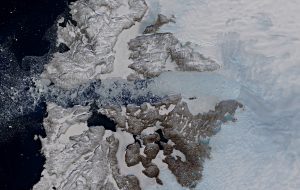 In recent years, Greenland has been losing more ice through the Jakobshavn Glacier than from anywhere else on this huge ice sheet. Various types of satellite data have been used to understand and monitor the glacier's flow during the last 20 years, revealing that the glacier was flowing at its fastest and losing the most ice in 2012-13. In places, the main trunk of the glacier was deflating by 10 meters a year as it adjusted dynamically to ice loss and melting.
In recent years, Greenland has been losing more ice through the Jakobshavn Glacier than from anywhere else on this huge ice sheet. Various types of satellite data have been used to understand and monitor the glacier's flow during the last 20 years, revealing that the glacier was flowing at its fastest and losing the most ice in 2012-13. In places, the main trunk of the glacier was deflating by 10 meters a year as it adjusted dynamically to ice loss and melting.
However, information from satellites such as ESA's CryoSat and the Copernicus Sentinel-1 mission show that between 2013 and 2017, the region drained by the glacier stopped shrinking in height and started to thicken. The overall effect is that Jakobshavn is now flowing more slowly, thickening, and advancing toward the ocean instead of retreating farther inland. This image was taken by the Copernicus Sentinel-2 mission on April 29, 2019.
Image Credit: Contains modified Copernicus Sentinel data (2019), processed by ESA

